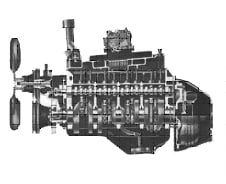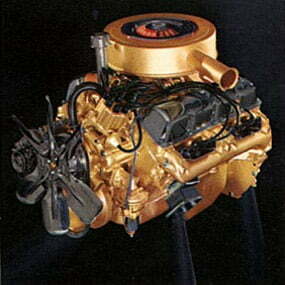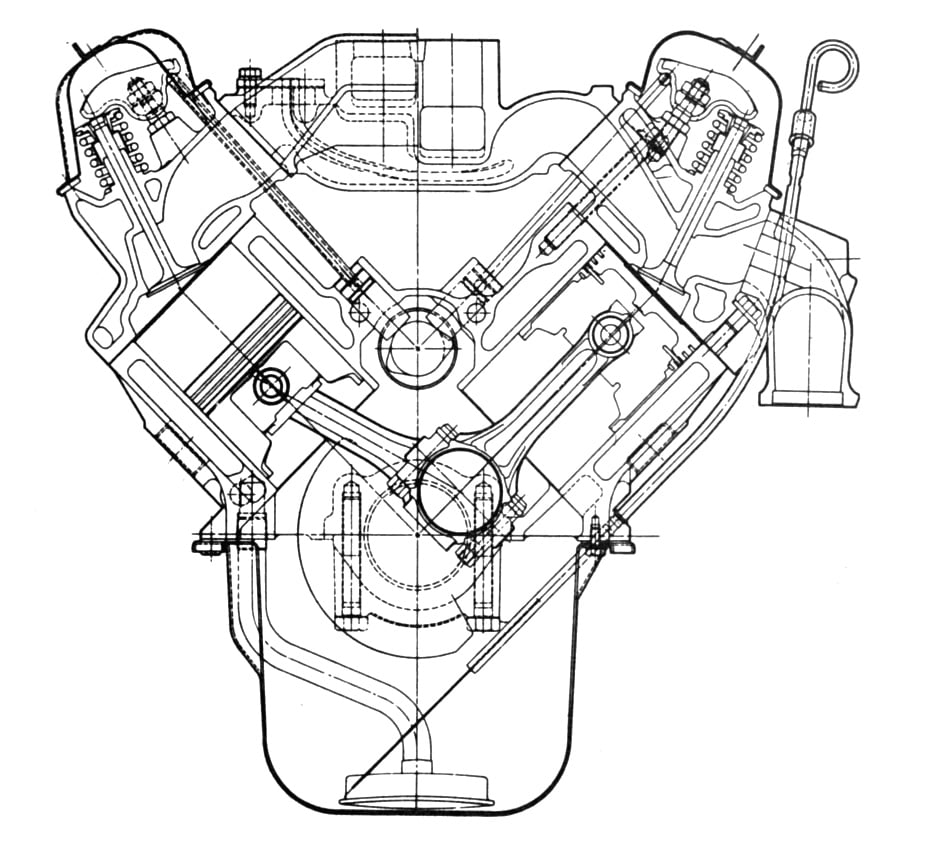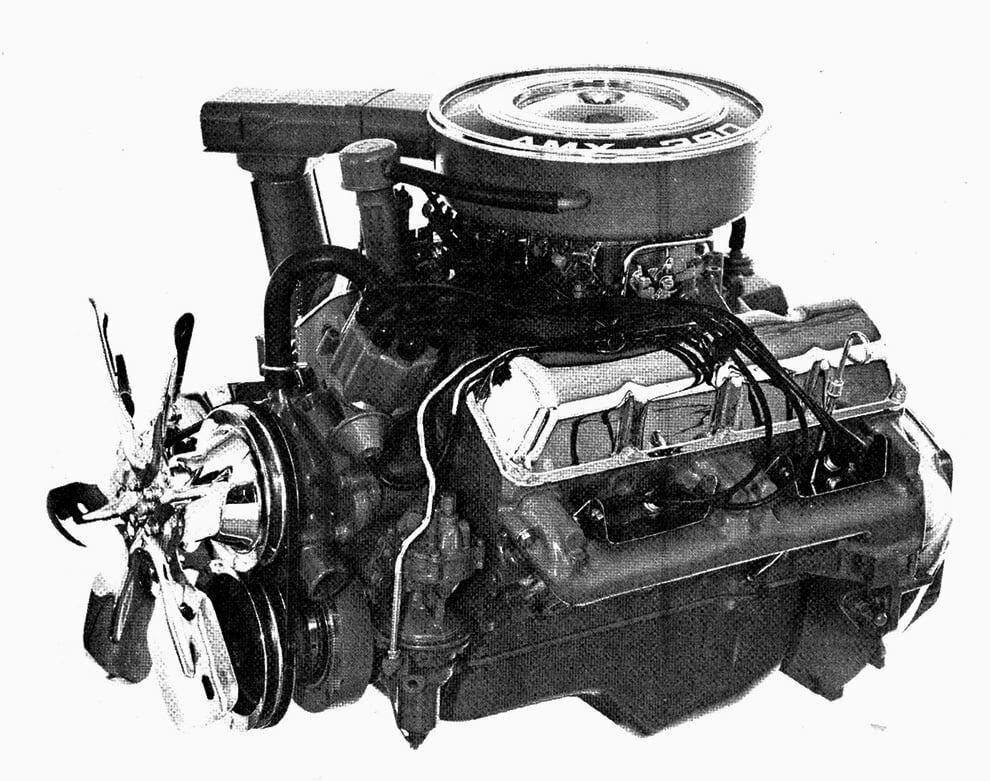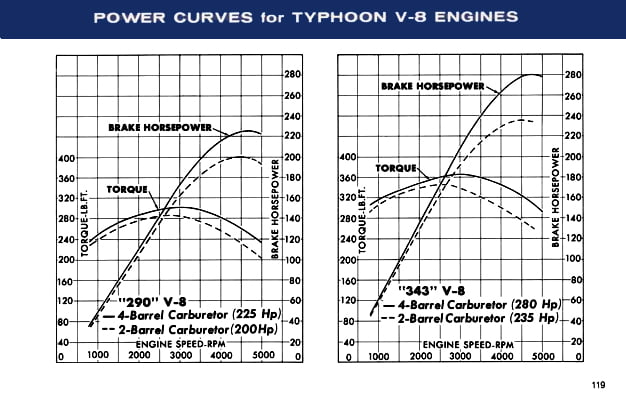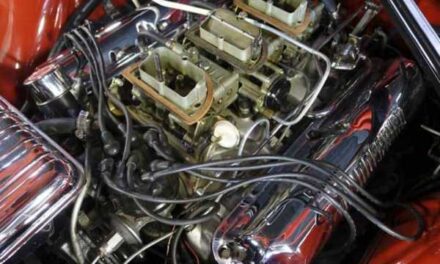Gen 2 Short-Deck AMC V8 – General Information
Gen 2 AMC V8 – General Information
New V8 engines from almost every manufacturer were introduced in the mid-1960s. Engineering advances in casting and lessons learned in volumetric efficiency (read cylinder head design) that were learned in the racing programs that all the factories had been involved in during the late 50s began to be applied at this time. Also, the push to the economy resulting from the recession in the early 60s had resulted in a quest for lighter weight as well, so even as America went back to its thirst for large cubic inch V8s, the public demanded more power per specific volume and better designs that made more horsepower.
Thus even small American Motors had to come up with a replacement for its aging “big block”. The fact that they were a smaller company that had pioneered efficient cars worked in its favor in this instance. AMC’s new design was built to be able to span what we call “small block” to “big block” displacements, running in its lifetime 290 cu. in. all the way to 401 cu. in., and with a capability to go to over 450 cu. in.
AMC never had the requirement to build a V8 over 401 cu. in., because none of their vehicles weighed enough to require big inches to move them along at a reasonable pace. That advantage allowed the engine to survive until 1984 even after Chrysler took over the brand. The 360 and 401 GEN-3 engines discussed in another section were used until the Kenosha, Wisconsin engine plant was closed.
This new generation of AMC V8s was first introduced in 1966 at 290 cu. in. It is sometimes referred to as the “GEN-2” AMC V-8. All three engine sizes that originally spawned from this block (290, 343, and 390) share the same basic design. The different displacements are achieved through various bore and stroke combinations. The key to an AMC enthusiast is that all blocks share the same external measurements and thus can be swapped easily.
There was a popular myth that the GEN-2 AMC V8 was built by Ford because they did share some electrical parts (starter and distributor) with Ford, and some models used Motorcraft (Ford) carburetors. This is totally untrue; the engine design is totally different and was developed in-house in Kenosha Wisconsin.
Bore center measurement was kept the same as the original GEN-1 AMC V-8 so that the factory’s then-in-use boring equipment could be retained. But aside from this measurement, the engine shares little with the GEN-1. The GEN-1 engine was physically the size of the big-block Ford, Mopar or GM engines, and in many cases is referred to as a “big-block” design, even though it was never expanded past 327 cu. in.
But the GEN-2 is dimensionally closer to the physical size of other US-made small-block V-8s of the time, except at the bore centers, which are the same as some big-block engines, much like Buick and Oldsmobile small blocks. There are no shared parts between the AMC GEN-1 and the GEN-2/GEN-3 engines. The new engine was a completely new design.
The major difference between the GEN-2 and GEN-3 engines was the deck height. GEN-2 engines had a deck height of 9.165″. GEN-3 engines, introduced in 1970, had a change in deck height to 9.208″ to accommodate the GEN-3’s longer stroke. The height difference affects the intake manifold fitment and push rod interchangeability between GEN-2 and GEN-3 engines.
The GEN-2 AMC V-8 was first introduced at 290 cu. in. (4.8 L), in 1966. At that time it was used exclusively in the Rambler American model as an option in the Rambler Rogue. In 1967 a 343 cu. in. V8 was developed and introduced across the board and was the “big block” for all AMC models (it was even an option in the Rogue, turning that model into a muscle car. The 390 cu. in. (6.4L) arrived in February 1968 for use first in the AMX, though it became an option in the Javelin as well.
These three engines remained unchanged through 1969. In 1969 the 390 became available as an option in the Rebel, the Classic, and the Javelin. It even saw service in the Rogue, which when fitted with the 390 was called the SC/Rambler (known as the “Scrambler”), and it could scramble – with quarter-mile speeds of just about 100 mph and elapsed times in the low 14 seconds in stock trim. In NHRA setup, this car could hit over 140 mph – and some SC/ramblers recorded ETs in the low 12-second range.
The cylinder head used on the GEN-2 was the “rectangle port”, named after the exhaust port’s exit shape. The 290 heads used smaller valves, 1.787″ intake, and 1.406″ exhaust, in order to preclude interference problems with the small bore. The 343 and 390 used the same heads but fitted with larger valves; 2.025″ intake and 1.625″ exhaust. These valve sizes are compared favorably with the high-performance offerings of the Big Three.
Horsepower was likely underrated in these engines or perhaps was not overrated as much as their competitors were. The AMC 4-barrel carbureted motors were rated at 225 hp for 290, 280 hp for 343, and 315 hp for 390. Most of their Big 3 competitors (GM especially) had engines of around 330 – 350 cu. in. showing 300 or better in 4 barrel trim and their 380 – 400 cu. in. engines advertising 350 hp or better. Quarter mile performance tells us that the AMC motors made comparable horsepower.
Engine Types Described
290 V8
The base 290 cu. in. V8 advertised 200 hp with a 2 bbl. carburetor and 8.7:1 compression ratio. The optional 225 hp 290 used a 4bbl. carburetor and 10.0:1 compression ratio. The 290 was manufactured from 1966 through 1969. In 1970 it was replaced by the GEN-3 304 V8. It had a 3.75″ bore and 3.28″ stroke, with 1.787″ intake and 1.406″ exhaust valves.
343 V8
The 2 bbl. carb 343 cu. in. had 8.7:1 compression and produced 235 hp. Output for the optional 4bbl. carburetor version with 10.2:1 compression ratio was 280 hp. The 343 was manufactured from 1966 through 1969. In 1970 it was replaced by the GEN-3 360 V8. The 343 had a 4.08″ bore and 3.28″ stroke, with 2.025″ in intake and 1.625″ exhaust valves.
390 V8
In addition to the largest bore and stroke of the GEN-2 engines, the 390 cu. in. AMX 390 motor also was a different block with heavier main bearing support webbing and a forged steel crankshaft and connecting rods. The forged cranks and rods were used for their known strength as there was not sufficient time for testing cast parts for durability without slipping AMC’s desired introduction schedule. Most important was that the 390 was always intended as a high performance engine, hence its introduction in the AMX.
The GEN-2 390 produced 315 hp (340 hp in the AMX SST) and was manufactured in 1968 and 1969 only. The 1970 390s used the GEN-3 401 block and different rods and pistons. Bore is 4.165″ and stroke is 3.68″. 2.025″ intake and 1.625″ exhaust valves were fitted.
Maximum factory recommended overbore was only 0.020″ due to the “thin wall” light weight design, but GEN-2 390 engines are commonly bored 0.030″ over with no problems.
AMC Engine Specifications from 1966 to 1969
| Year | Engine Cu. In. Carb Type | Horespower @ RPM | ft.lbs. Torque @ RPM | Comp. Ratio | Bore Stroke | Intake Valve | Exhaust Valve |
| 1966 | 290-2B | 200 @ 4700 | 285 @ 2800 | 8.7:1 | 3.750" x 3.280" | 1.787" | 1.406" |
| 1967 | 290-2B | 200 @ 4700 | 285 @ 2800 | 8.7:1 | 3.750" x 3.280" | 1.797" | 1.406" |
| 290-4B | 225 @ 4800 | 300 @ 3200 | 10.0:1 | 3.750" x 3.280" | 1.797" | 1.406" | |
| 343-2B | 235 @ 4400 | 345 @ 2600 | 8.7:1 | 4.080" x 3.280" | 2.000" | 1.625" | |
| 343-4B | 280 @ 4800 | 365 @ 3000 | 10.0:1 | 4.080" x 3.280" | 2.000" | 1.625" | |
| 1968 | 290-2B | 200 @ 4700 | 285 @ 2800 | 8.7:1 | 3.750" x 3.280" | 1.797" | 1.406" |
| 290-4B | 225 @ 4800 | 300 @ 3200 | 10.0:1 | 3.750" x 3.280" | 1.797" | 1.406" | |
| 343-2B | 235 @ 4400 | 345 @ 2600 | 8.7:1 | 4.080" x 3.280" | 2.025" | 1.625" | |
| 343-4B | 280 @ 4800 | 365 @ 3000 | 10.0:1 | 4.080" x 3.280" | 2.025" | 1.625" | |
| 390-4B | 315 @ 4600 | 425 @ 3200 | 10.2:1 | 4.165" x 3.574" | 2.025" | 1.625" | |
| 1969 | 290-2B | 200 @ 4700 | 285 @ 2800 | 8.7:1 | 3.750" x 3.280" | 1.792" | 1.411" |
| 290-4B | 225 @ 4800 | 300 @ 3200 | 10.0:1 | 3.750" x 3.280" | 1.792" | 1.411" | |
| 343-2B | 235 @ 4400 | 345 @ 2600 | 8.7:1 | 4.080" x 3.280" | 2.030" | 1.685" | |
| 343-4B | 280 @ 4800 | 365 @ 3000 | 10.0:1 | 4.080" x 3.280" | 2.030" | 1.685" | |
| 390-4B | 315 @ 4600 | 425 @ 3200 | 10.2:1 | 4.165" x 3.574" | 2.030" | 1.685" | |
| 390-4B (AMX SST) | 340 @ 4800 | 430 @ 3400 | 12.2:1 | 4.165" x 3.574" | 2.080" | 1.740" |
Gen 2 290
Gen 2 290 in cutaway. Note the compact, lightweight design. The AMC Gen 2-3 engines packed a lot of punch for their size.
Gen 2 V8 in cross-section
Gen 2 V8 in cross-section (290 shown). Except for bore and stroke, all Gen 2 engines were physically the same, and could share heads, cam, and intake.

